Cauliflory
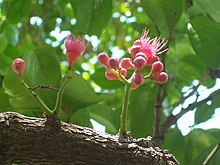
Flowers growing from the hard and woody horizontal stem of a Syzygium moorei, Australia

Jackfruits growing directly from the trunk
Cauliflory is a botanical term referring to plants that flower and fruit from their main stems or woody trunks rather than from new growth and shoots.[1] This can allow trees to be pollinated or have their seeds dispersed by animals which cannot climb or fly.[2] With fruit, plants may instead have fruit which drop from the canopy and ripen only after they reach the ground, an alternative "strategy" to cauliflory. (Note that the concept of cauliflory includes that of ramiflory.[1])
Families, genera and (some) species
(list incomplete)
Moraceae
Ficus: F. racemosa, F. sansibarica, F. sur, F. sycomorus
Artocarpus: A. heterophyllus (jackfruit), A. integer (cempedek, breadfruit)
Myrtaceae
Syzygium S. moorei, S. cormiflorum
Plinia: P. cauliflora
Malvaceae
Theobroma: T. cacao[3] (and possibly others)
Cola:[4]C. mossambicensis (and possibly others)[4]
Crescentia: C. cujete (calabash tree).[5]
Pavonia: P. strictiflora
Fabaceae
Cercis: C. siliquastrum[6]
Castanospermum: C. australe
Meliaceae
Dysoxylum spp. including D. parasiticum (ramiflorous)[7] and D.spectabile[8]
Sapindaceae
Pancovia:[9]P. golungensis(False soap-berry)[10]
Caricaceae
Carica papaya (Papaya)
Putranjivaceae
Drypetes natalensis (Natal ironplum) (and possibly others)[11]
Sapotaceae
Englerophytum magalismontanum (Stamvrug)
Stilbaceae
Halleria lucida[12] (Tree fuchsia)
Annonaceae
Uvariopsis (all species are ramiflorous, cauliflorous or both.)[13] Cauliflorous species are: U. submontana[14]. U. sessiflora,[13]U. congolana,[13]U. guineensis,[13]U. vanderystii,[13]U. noldeae,[13]U. doica,[13]U. letestui,[13]U. bakeriana,[13]U. solheidii,[13]
Oxalidaceae
Averrhoa bilimbi[15]
Image gallery
Syzygium moorei fruit

Ficus (fig)

Coffee Plant (Coffea)
Cercis siliquastrum
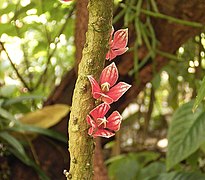
Pavonia strictiflora

Castanospermum australe

Hippophaë rhamnoides
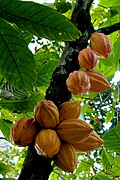
Theobroma cacao
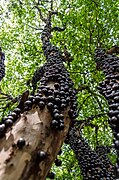
Jabuticaba (Plinia cauliflora)
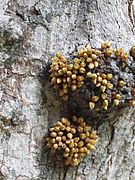
Englerophytum magalismontanum
Halleria lucida
See also
- Ramiflory
- Spur
References
^ ab "PlantNET: NSW Flora Online: Glossary of Botanical Terms: C, Royal Botanic Garden Sydney, Australia". Retrieved 23 April 2018..mw-parser-output cite.citation{font-style:inherit}.mw-parser-output q{quotes:"""""""'""'"}.mw-parser-output code.cs1-code{color:inherit;background:inherit;border:inherit;padding:inherit}.mw-parser-output .cs1-lock-free a{background:url("//upload.wikimedia.org/wikipedia/commons/thumb/6/65/Lock-green.svg/9px-Lock-green.svg.png")no-repeat;background-position:right .1em center}.mw-parser-output .cs1-lock-limited a,.mw-parser-output .cs1-lock-registration a{background:url("//upload.wikimedia.org/wikipedia/commons/thumb/d/d6/Lock-gray-alt-2.svg/9px-Lock-gray-alt-2.svg.png")no-repeat;background-position:right .1em center}.mw-parser-output .cs1-lock-subscription a{background:url("//upload.wikimedia.org/wikipedia/commons/thumb/a/aa/Lock-red-alt-2.svg/9px-Lock-red-alt-2.svg.png")no-repeat;background-position:right .1em center}.mw-parser-output .cs1-subscription,.mw-parser-output .cs1-registration{color:#555}.mw-parser-output .cs1-subscription span,.mw-parser-output .cs1-registration span{border-bottom:1px dotted;cursor:help}.mw-parser-output .cs1-hidden-error{display:none;font-size:100%}.mw-parser-output .cs1-visible-error{font-size:100%}.mw-parser-output .cs1-subscription,.mw-parser-output .cs1-registration,.mw-parser-output .cs1-format{font-size:95%}.mw-parser-output .cs1-kern-left,.mw-parser-output .cs1-kern-wl-left{padding-left:0.2em}.mw-parser-output .cs1-kern-right,.mw-parser-output .cs1-kern-wl-right{padding-right:0.2em}
^ Jeremy M.B. Smith. "Tropical forest: Population and community development and structure: Relationships between the flora and fauna -- Encyclopædia Britannica". Retrieved 2008-03-07.
^ Govaerts, R. et al. (2018) "Theobroma cacao". Plants of the World online. Retrieved 22 April 2018.
^ ab Govaerts, R. et al. (2018) "Cola". Plants of the World online. Retrieved 22 April 2018.
^ "Crescentia cujete - the calabash tree". Tropilab. Inc. Retrieved 22 April 2018.
^ Govaerts, R. et al. (2018) "Circis siliquastrum". Plants of the World online. Retrieved 22 April 2018.
^ Govaerts, R. et al. (2018) "Dysoxylum parasiticum ". Plants of the World online. Retrieved 22 April 2018.
^ "Dysoxylom spectabile". NZflora. Retrieved 22 April 2018.
^ Govaerts, R. et al. (2018) "Pancovia ". Plants of the World online. Retrieved 22 April 2018.
^ Govaerts, R. et al. (2018) "Pancovia golungensis ". Plants of the World online. Retrieved 22 April 2018.
^ Govaerts, R. et al. (2018) "Drypetes". Plants of the World online. Retrieved 22 April 2018.
^ "Halleria lucida". GBIF. Retrieved 22 April 2018. (See images)
^ abcdefghij (in French) Gereau, E. R., & Kenfack, D. (2000). Le genre Uvariopsis (Annonaceae) en Afrique tropicale, avec la description d’une espece nouvelle du Cameroun. Adansonia, 22(1), 39-43.
^ Cheek, M. (2014) "Uvariopsis submontana. The IUCN Red List of Threatened Species 2014: e.T45421A3001680". Retrieved 22 April 2018.
doi:10.2305/IUCN.UK.2014-3.RLTS.T45421A3001680.en.(See images)
^ Ahmed, QamarUddin; Alhassan, AlhassanMuhammad (2016). "Averrhoa bilimbiLinn.: A review of its ethnomedicinal uses, phytochemistry, and pharmacology". Journal of Pharmacy and Bioallied Sciences. 8 (4): 265–271. doi:10.4103/0975-7406.199342. ISSN 0975-7406. PMC 5314823. PMID 28216948.
External links
| Wikimedia Commons has media related to Cauliflory. |
| Look up cauliflory in Wiktionary, the free dictionary. |
- The Truth About Cauliflory
- Cauliflory in Malaysian Rainforest Trees
This botany article is a stub. You can help Wikipedia by expanding it. |










